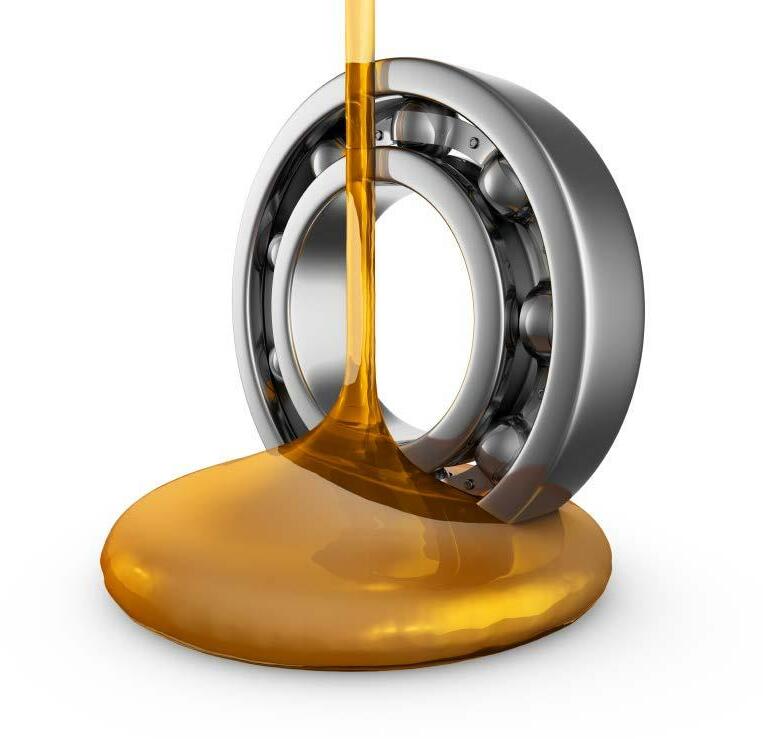
21 minute read
Complex Issue of Dropping Point Enhancement in Grease
Joseph P. Kaperick, Gaston Aguilar, Ken Garelick, Amanda Miller, Michael Lennon, Michael Edwards Afton Chemical Corporation
Abstract
The steady increase in the percentage of complex greases in NLGI’s survey of global grease production is a reflection of the demand for lubricants that will last longer in more severe, higher temperature applications. It is also a clear indicator that future research and development work will be of great value in this area of lubrication. The surge in demand for higher dropping point greases has brought additional interest in alternative methods of producing them that can reduce cycle times and, potentially, overall production costs. A study was undertaken to investigate different borate chemistries used to raise the dropping point of lithium greases to the level usually associated with complex greases. Points of focus include a design of experiment to study the impact of common factors on the effectiveness in raising dropping point, as well as a closer look at the impact of dropping point apparatus, blending temperature and correlation to effects as measured by high temperature rheology.
Introduction
According to the NLGI Annual Production Survey, lithium complex base grease production has increased by almost 50% since 2006 and has followed a steady upward trend as demands on equipment, and the greases needed to lubricate it, have grown. Last year, the share of lithium complex grease as a portion of total global production was reported at nearly 20%, or over 488 million pounds. [1]
The traditional method of making lithium complex greases typically involves the use of organic acids (such as azeleic or sebacic acid) during the soap production process which can extend the cycle time and add complexity to the production process. The more recent use of amine borates, borate esters and even boronated dispersants has offered a simplified process that has the potential to reduce cycle time and production complexity.
Background
Recent work has looked at various aspects of the use of borated componentry including research by Deshmukh which focused on the use of borate esters in greases made from hydrogenated castor oil [2], and work done by Lorimor comparing the conventional complexation process using azelaic acid with a post-treatment using a boron ester. [3]
Additionally, Shiller examined the effect of some boroncontaining chemistry on fretting wear using the Fafnir fretting rig (with the standard test method ASTM D 4170) and the Falex Block-on-Ring test [4], while Yao examined a synergistic interaction between borate ester and zinc dialkyl dithiocarbamate that appears to provide antiwear improvement. [5]
One of the main differentiation points between simple lithium greases and lithium complex greases is the higher dropping points measured in the complexes. Several papers have investigated the high temperature behavior of greases by a variety of methods including high temperature bearing rig tests, PDSC, high temperature rheology and dropping point. [6] [7] [8] [9] [10] [11] [12] And Coe looked at applications for grease and how the claims for high temperature performance related to dropping point, as well as to a variety of high temperature bench tests.[13]
A large variance in measured dropping points when base greases were treated with the same borate component has been observed in the authors’ lab during work with a variety of customer projects. The current investigation was undertaken to further understand the interactions of different types of borate componentry with simple lithium greases made under different conditions and the reason for the large variations seen in dropping point. An example of the variation in response is seen in Table 1.
Furthermore, some of the literature points to a synergism seen when the borate chemistry is added in the presence of
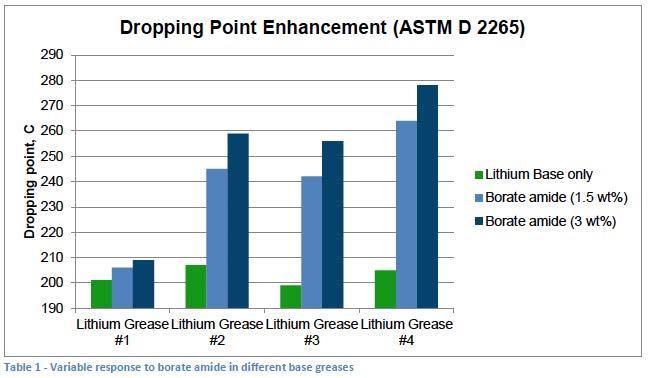
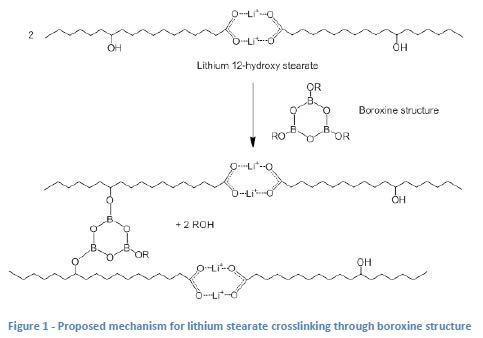
zinc dialkyl dithiophosphate (ZDDP) and this interaction was included in the study.
Historically, greases made from hydrogenated castor oil (HCO) don’t appear to respond well to the use of borate componentry to raise dropping point [2]. The authors hypothesized that this is due to the preferential reaction of the borate component with glycerin which is present in these greases because it is generated as a by-product of the soap process when HCO is used (see Figures 1 and 2). This means that there is very little of the boroxine componentry left to be able to crosslink (and stabilize) the lithium stearate.
A designed experiment (DOE) was used to look at the effects of three different borate components in greases along with various levels of glycerin, alkalinity, and water content. Additionally, the presence (or absence) of ZDDP was included as a variable in the study.
Experiment
Test Methods
ASTM D2265 “Standard Test Method for Dropping Point of Lubricating Grease Over Wide Temperature Range” [14]
This method determines a numerical value for a grease composition representing the temperature at which the first drop of material falls from the test cup and reaches the bottom of the test tube. The temperature is measured using a thermometer placed near the grease sample inside a glass tube placed in an aluminum block at a preset constant temperature. A modification was used for this work in that the block temperature used for all determinations was 288 °C. This was done to ensure that the heating rate was the same for each sample. However, the dropping point was also determined using different block temperatures as described in D2265 and no statistical difference was seen between the determinations.

Base Greases
As the alkalinity of the base grease is known to affect various aspects of additive performance [15], two simple lithium base greases were made in the lab. One was targeted to be slightly basic while the other was targeted to be very basic. Both were made using 12-hydroxystearate acid (12-HSA) as the fatty acid with sufficient lithium hydroxide (LiOH) to meet the targeted alkalinity for each. Both greases were milled and diluted with base oil that had a kinematic viscosity at 40°C of 165 cSt (a mixture of AC 600N [68%] and AC bright stock [32%]) to obtain greases that were slightly harder than an NLGI #2 grade base which allowed for some softening due to addition of various componentry in the study. See Table 2 for descriptive data for these base greases.
Both greases were then dried at 80 °C in a vacuum oven for 24 hours.
Each base grease was then split into two equal parts with one part being treated with 500 ppm DI water (mixed in slowly by hand and with Hobart mixer) while the second part was kept “dry”. This gave four greases (Base A through D, as shown in Table 3) to be used in the designed experiment. The dropping point of each base grease was measured as a baseline.
Additive components/levels
As part of the designed experiment, a high and low level for each component was needed. The level of glycerin added was calculated from the amount of glycerin that would have theoretically been produced as a byproduct if the laboratory-produced grease had been made with HCO instead of 12-HSA. This level was determined to be 1.2 wt%. The low level used was zero with a midpoint level of 0.6 wt%.
The specific ZDDP component used has a mixed-chain length (C4/C5/C8) and was made from a primary alcohol. The level of ZDDP used was based on that which was seen to be effective in screening work with similar greases and the borate components of interest. The high level was set at 1.13 wt%, with a low level of zero and a midpoint level of 0.56 wt%.
The level of borate used was determined empirically (see Table 4). Since the goal of the study was to be able to observe both positive and negative effects, it was decided to use a level that gave a “mid-range” result that would allow for observation of improvement or deterioration. This level (1.5 wt% of borate amide) gave a boron concentration of 300 ppm and it was decided to use this same level for each of the boronated components.
The types of borates used were borate amide (BA), borated dispersant (BD) and borated/phosphorylated dispersant (BPD). The components and the treat rates used to achieve a 300 ppm boron level are shown in Table 5.


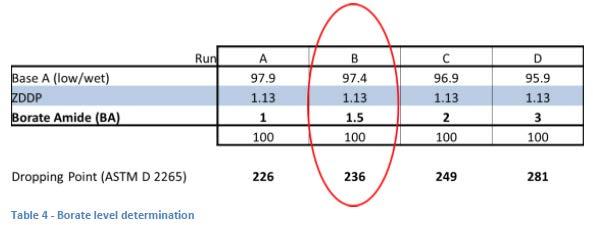
Design of Experiment
A statistically designed experiment was set up consisting of 24 runs and 9 midpoints (3 for each of the different borate components). See Table 6 for the entire design. It was determined that this design would allow adequate evaluation of repeatability to be able to see any significant effects due to the different variables. As described above, the dropping points were determined for the entire set using a block temperature of 288 °C (although statistical analysis of determinations run at higher and lower block temperatures showed no differences).
Analysis of the data resulted in a good model (p <0.0001) with the only factor of high significance (i.e. with p<0.05) being glycerin (p<0.0001). The common interpretation of this data is that the likelihood of the difference seen being due to random error is less than 0.01%. The leverage plot (see Figure 3) shows that, as hypothesized, higher levels of glycerin give lower dropping points while higher dropping points are measured in the absence of glycerin.
There were also some indications that two of the borate species (BPD and BD) were significant although with a lower degree of probability (0.05<p<0.10). In both cases, it appears that higher levels of the borates can produce greases with higher dropping points.
Overall, the results of this first DOE did not appear to show the significance of the borate chemistry that was expected. It was thought that this might be due to using lower treat rates than are often used in commercial formulations. For this reason, the design was augmented with eight additional runs using twice the initial concentration of BA taking the total level of boron up to 600 ppm in each sample. The design was augmented in such a way as to keep it balanced allowing for good statistical analysis of the resulting data.
As can clearly be seen in Figure 4, when glycerin is not present the concentration of BA has an impact on dropping point whereas when glycerin is present, the level of BA present has no impact on dropping point.


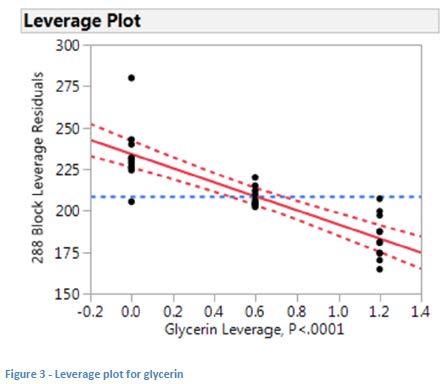
Due to the observed impact of the glycerin, the data without glycerin was modeled separately and while none of the individual components appeared to be significant, a three-way interaction between LiOH level, water content and ZDDP was observed. It is thought that the borate level may have been too low to show up as significant (as seen by the impact of BA at higher levels in the augmented design).
The data was then modeled including the augmented runs (in which BA was doubled for eight additional runs) and this model shows that both LiOH level (see Figure 5) and ZDDP (see Figure 6) have a positive impact on dropping point at the higher level of BA. This may confirm the original observation that the treat rates of BD and BPD were too low to be significant in the original model.

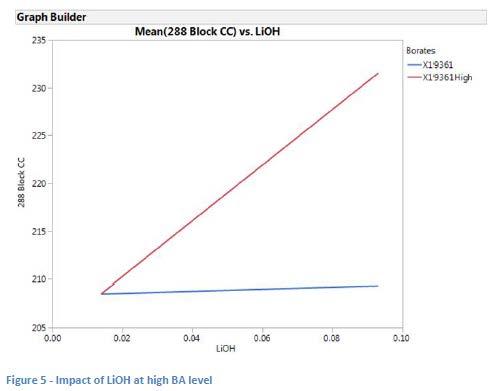
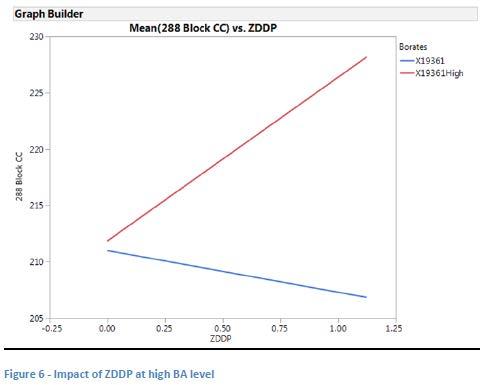
The overall model for the data at the high borate level (see Table 7) shows that LiOH content has a positive impact on dropping point, while the impact of glycerin was negative. ZDDP was shown to be somewhat significant as well (p 0.1) with a potentially positive impact on dropping point.
Summary and Conclusions
In each of the models that were examined, glycerin was shown to be statistically significant in having a negative impact on dropping point. This would appear to support the hypotheses that glycerin is reacting with the borate species thus preventing it from helping to complex the grease and provide high temperature stability. This is further supported by the data that shows BA to have a significant impact on raising dropping point in the absence of glycerin.
The treat rate of the borates used was also shown to be important with the initial treat of 300 ppm boron content potentially being too low to show significance especially in the presence of higher levels of LiOH and ZDDP.
The three-way interaction seen between LiOH, water and
ZDDP (in the absence of glycerin) was an interesting finding showing that high levels of each could have a positive impact on the ability of the borate to raise dropping point. One hypothesis to explain the observed interaction is that the excess LiOH is reacting with ZDDP to allow formation of a zinc stearate which could allow more efficient complexation by the borate chemistry. This process could be facilitated by the presence of excess water. Obviously, further study would be needed to better understand this interaction and to provide further evidence for its mechanism.
Additional Experiments
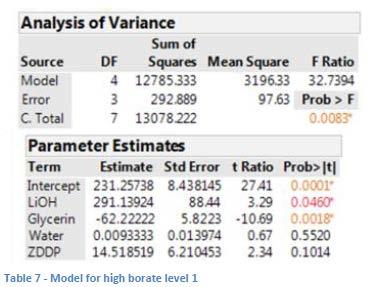

Aging of Dropping Point Cups
During the course of this work, several observations led to additional experimentation. The first observations related to the age of the brass cups used for dropping point determinations according to ASTM D2265. Though not well documented, there was some experience by laboratory personnel that pointed to different results being obtained with “new” cups as compared to “old” cups.
The ASTM method specifies:
“8.1 Thoroughly clean the cup, cup support, and test tube with mineral spirits. (Warning—Flammable. Vapor harmful.) 8.2 Use only cups that are clean and free of any residue. When the interior plating of the cup shows indications of wear, discard.” [14]
A quick study was carried out doing triplicate runs of greases containing three different borates. One set of the triplicate runs was carried out with cups that had been previously used (although the age or number of runs for each cup was not known) and the second set of triplicate runs was carried out using a new cup for each determination. The results (see Table 8) show that the older cups give a higher result for seven out of the nine determinations while using the new cup resulted in a higher value only once.
To further study the possible effect of aging the cup on the determined dropping point, a second study was conducted in which a grease which had shown a moderately high dropping point was run repeatedly using the same cup which was new at the start of the study (see Figure 7). There is an apparent increase in the obtained results that plateaus after the third run but which appears to cause an increase of about 15°C in the dropping point result. Two additional runs carried out with brand new cups appear to confirm this difference between new and used cups.
Heat/Method of Borate Incorporation
A separate study was being conducted with the borate amide (BA) at 1.0 wt% and several inconsistent results were obtained ranging from 230 °C to 293 °C (see Table 9). A short experiment was undertaken to look at the effect of heating and blend order of the components used. Standard mixing had been at 60 °C in a centrifugal mixer and this was repeated at 104 °C on the original samples and a reblend. A high dropping point was obtained (No Drop) using the original temperature of 60 °C but the higher temperature seemed to have no effect. The order of addition also seemed to show no effect. The borate was added first and homogenized within the grease at 60 °C then the additional components were added at 104 °C to observe whether there was some effect of using higher heating
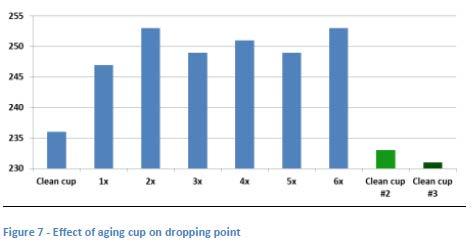
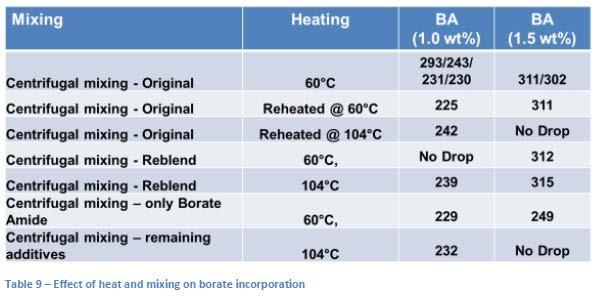
to carry out further complexation of the grease. These components included ZDDP which can show synergistic behavior with BA as seen in the first study above.
However, when the conditions were all repeated using a higher treat rate of the BA component (1.5 wt%), reproducibly high results were obtained under each of the conditions except for the case where the borate amide was added before ZDDP was present in the mixture (which was to be expected given the synergistic behavior previously noted with ZDDP).
Based on these results it would appear that once there is a sufficient amount of borate in the grease to carry out the complexation completely, the heat and order of addition have little impact. When there is a lower level of borate in the grease, there is higher variability in the results obtained. This led to a closer examination of the actual determination of dropping point and observation of how the drop is formed in the apparatus.
Effect at High Temperature
It had been observed that in some determinations, a drop forms and is can be seen to continue to grow larger but before it drops (which would end the analysis according to D2265), it begins to shrink and appears to harden as the temperature in the cup continues to rise. This action is illustrated in a series of pictures (see Figure 8). This behavior would appear to indicate that some kind of physical and/or chemical change is occurring in the grease as the temperature of the cup (and grease) rises during the analysis.
To further examine this aspect, a series of high temperature rheology determinations were carried out on an Anton-Paar oscillatory rheometer (MCR301). The grease samples were compressed between a temperature-controlled Peltier bottom plate and a parallel top plate. A hood which contains a temperature-controlled Peltier device was placed over the test grease and bottom plate. A temperature sweep (from 40 °C to 200 °C) was performed on the sample greases while maintaining a low strain.
The “Tan Delta” of the grease is a ratio of the loss modulus (G”) and the storage modulus (G’). Higher values of this ratio indicate more liquid-like behavior in a grease and a ratio above a value of 1 (also known as the “Flow Point”) indicates a change from solid to liquid behavior similar to what might be expected at the dropping point of a grease. In Figure 9, this ratio is plotted and shows the effect of raising temperature in a manner similar to that which the grease is exposed to in a dropping point cup.
In this small study, Grease A is a simple lithium grease treated with the borate amide (BA) at 1.5 wt%, while Grease B is a different simple lithium grease treated with the boronated, phosphorylated dispersant (BPD) at 3.0 wt%. These plots show

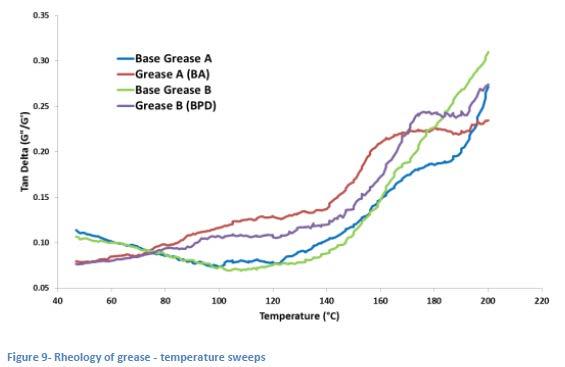
the behavior of the different greases in the temperature range (between 140 °C and 200 °C) at which the drop formations were observed in Figure 8 above. The plots show the relatively smooth transition from more solid to more liquid behavior of both Base Grease A and Base Grease B, whereas the additized greases show a clear “plateau” effect beginning at around 160 °C to 170 °C which correlates reasonably well with the apparent reversal of the drop formation and observed “solidification” of the drop in the dropping point apparatus. Both of these greases had dropping points of about 300 °C but the rheometer was not capable of going beyond 200 °C with the heating element that it was equipped with.
A rheometer with higher heating capacity was obtained and additional runs were carried out with similar high dropping point greases which were also complexed using a combination of ZDDP and borate componentry. These greases were run using the same temperature sweep program but were able to be heated up to 300 °C by the end of the program. These plots are shown in Figure 10 along with a plot of a simple lithium base grease.
Here it can clearly be seen that the base grease reaches a Tan Delta of >1 (indicative of more liquidlike behavior) at just over 200 °C which correlates very closely with its dropping point. The other three additized greases were all measured to have dropping points in the 300 °C range and the same “plateau” behavior is seen between 120 °C and 200 °C before the Tan Delta starts to increase again between 220 °C and 300 °C. This seems to correlate well with the plots shown in Figure 9, as well as with observations of the dropping point apparatus as illustrated in Figure 8. This also appears to provide more evidence that a physical change is occurring in these greases as they are being heated which may be affecting the ability of these samples to allow a drop of oil to be released during the test. It’s possible that this is a chemical reaction involving the borate components. Whether or not this is reflective of what happens in high temperature applications or even in high temperature bearing rig tests is unknown and needs further study.
In summary, a designed experiment showed a large negative impact of glycerin on the ability of borates to increase the dropping point of lithium greases which provides a convincing explanation for the difficulty seen in using borates to raise dropping points in lithium greases made with hydrogenated castor oil. Additionally, the designed experiment showed the positive impact of higher levels of LiOH, ZDDP and perhaps water in raising dropping points. A possible explanation was proposed but would need further experimentation to provide
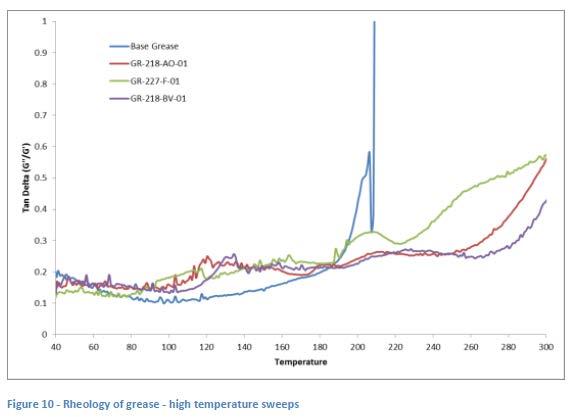
further evidence.
Although heating to 140 °C during the mixing process didn’t seem to effect results when there was an excess of borate available to react, there were inconsistent results at lower levels of borate which may be linked to the bimodal behavior seen with some greases (drop vs no drop in consecutive runs).
Additional experimentation and observations raised questions about the effect of aging on a dropping point cup with higher values being obtained with aged cups. High temperature rheometer scans showed evidence of physical changes within the grease which may correlate to observations showing drops that form but then harden rather than falling.
Additional study will focus on: - closer investigation of the surface of aged cups and how that might be linked to the higher dropping points observed - high temperature rheology and observation of behavior of “standard” complex greases as compared to those treated with borate chemistry - the correlation between grease behavior observed in the dropping point apparatus compared to high temperature bearing rigs or other high temperature applications - additional benefits of borate chemistry to other properties of a formulated grease including friction, wear and corrosion protection
References
1. NLGI Grease Production Survey Report, 2015. 2. Deshmukh, V., Rjput, B.K. “Evaluation of Boron Esters in
Lithium Complex Grease Prepared with Hydrogenated
Castor Oil, Preprint, Presented at the 82nd Annual NLGI
Meeting, Coeur d’Alene, ID, June 6-9, 2015. 3. Lorimor, John J. “An Investigation into the Use of Boron Esters to Improve the High-Temperature Capability of Lithium 12-Hydroxystearate Soap Thickened Grease”, 76th Annual
NLGI Meeting, Tucson, AZ, USA, June 13-16, 2009. 4. Shiller, Paul, “The Effect of Boron Additives in Grease on
Fretting Wear”, 75th Annual NLGI Meeting, Williamsburg,
VA, USA, June 7-10, 2008. 5. Yao, J., Zhao, J., Xi, Y. “The Antiwear Synergism between a Borate Ester and a Dialkyl Dithiocarbamate in Lubricating Oil and Grease”, Preprint, presented at the 72nd Annual
NLGI Meeting, San Antonio, TX, Oct 30 – Nov 1, 2005. 6. Rhee, I. “Prediction of High Temperature Grease Life Using a Decomposition Kinetic Model”, NLGI Spokesman, 74 (2010) 2, 28-35. 7. Pokhriyal, N.K., Nagar, S.C., Antony, J.P., George, T.P.,
Sayanna, E., Basu, B “Enhancing High Temperature Life
Performance of Lithium-Complex Greases”, Presented at the 80th Annual NLGI Meeting, Tucson, AZ, June 15-18, 2013. 8. Samman, N. “High Temperature Greases”, Presented at the
73rd Annual NLGI Meeting, Lake Buena Vista, Florida, Oct 29 - 31, 2006. 9. Nolan, S.J., Sivik, M.R., “The Use of Controlled Stress Rheology to Study the High Temperature Structural Properties of Lubricating Greases”, Presented at the 71st Annual NLGI
Meeting, Dana Point, CA, Oct 31 – Nov 2, 2004. 10. Sivik, M.R., Nolan, S.J. “Studies on the High-Temperature
Rheology of Lithium Complex Greases”, Presented at the 74th Annual NLGI Meeting, Phoenix, AZ, June 10-12, 2007. 11. Kaperick, J. “If You Can’t Stand the Heat...The Effects of
Temperature on Grease Additive Performance“, Presented at the 78th Annual NLGI Meeting, Desert Springs, CA,
June 11-14, 2011. 12. Ward, W. Jr., Fish, G. “Development of Greases with Extended Grease and Bearing Life Using Pressure Differential
Scanning Calorimetry and Wheel Bearing Life Testing”,
Presented at the 76th Annual NLGI Meeting, Tucson, AZ,
June 13-16, 2009. 13. Coe, C. “Shouldn’t Grease Upper Operating Temperature
Claims Have a Technical Basis?” NLGI Spokesman, 72 (2009) 10, 20-28. 14. ASTM D2265-15, “Standard Test Method for Dropping
Point of Lubricating Grease Over Wide Temperature
Range”, (2015) ASTM International, West Conshohocken,
PA. 15. Aguilar, G., Kaperick, J., Lennon, M., Keisler, M. “A Cursory Look at the Effects of Free Acid and Alkali on 12-Hydroxy Stearate Grease”, Presented at the 82nd Annual NLGI
Meeting, Coeur d’Alene, ID, June 6-9, 2015.
